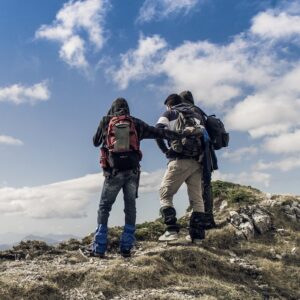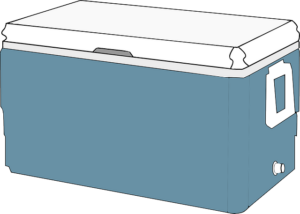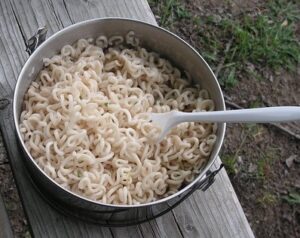Fueling Your Outdoor Adventure: A Guide to Safe and Delicious Camping Meals
 Spring has arrived, which means the Colorado outdoor adventure season is ramping up! Whether you are out for a day hike, car camping, or embarking on a multi-day backpacking trip, it is important to pack nutritious snacks and meals. However, there is no kitchen in the woods! When choosing your favorite trail foods, remember to keep food safety in mind to ensure everyone stays healthy and has an enjoyable experience.
Spring has arrived, which means the Colorado outdoor adventure season is ramping up! Whether you are out for a day hike, car camping, or embarking on a multi-day backpacking trip, it is important to pack nutritious snacks and meals. However, there is no kitchen in the woods! When choosing your favorite trail foods, remember to keep food safety in mind to ensure everyone stays healthy and has an enjoyable experience.
Planning For Food Safety
Consider your camping plans. If you are car camping, you may be able to bring a cooler with you. Coolers come in many shapes and sizes, but remember that plastic, fiberglass or steel coolers are the most durable and have the best “cold retention” power.  Styrofoam coolers also have good “cold retention” power but are far less durable and eco-friendly. While packing and camping, keep cold food cold in your cooler. Bacteria grows most rapidly on food in the danger zone – between 40 °F and 140 °F. To keep your cooler cold, pack gel ice packs, ice blocks, or freeze boxed drinks. Remember, a large block of ice will keep food colder for longer than ice cubes. While at the campsite, keep your cooler in the shade or under a blanket to preserve the ice. You can also purchase more ice throughout your trip if necessary. At the end of your trip, discard all perishable foods if there is no longer ice in the cooler. After the trip, wash and sanitize your cooler letting it air dry for your next big adventure.
Styrofoam coolers also have good “cold retention” power but are far less durable and eco-friendly. While packing and camping, keep cold food cold in your cooler. Bacteria grows most rapidly on food in the danger zone – between 40 °F and 140 °F. To keep your cooler cold, pack gel ice packs, ice blocks, or freeze boxed drinks. Remember, a large block of ice will keep food colder for longer than ice cubes. While at the campsite, keep your cooler in the shade or under a blanket to preserve the ice. You can also purchase more ice throughout your trip if necessary. At the end of your trip, discard all perishable foods if there is no longer ice in the cooler. After the trip, wash and sanitize your cooler letting it air dry for your next big adventure.
Food Safety Guidelines
The same food safety guidelines you follow at home apply in the outdoors too! Wash your hands and utensils before handling food to prevent the spread of bacteria. Be sure to use a biodegradable (camp) soap. If you are planning on cooking raw meat, bring a meat thermometer with you to ensure meat is cooked to the proper temperature. If possible, pack raw meat in a separate cooler to prevent cross contamination. Alternatively, you can precook your meat, store in your cooler while camping, and reheat as part of your camp meal. Another idea is to freeze the meat either raw or cooked before packing your cooler. This can also serve as a way to keep your cooler cold while it is thawing. Remember to pack your cooler with raw meats on the bottom and ready to eat foods on the top.
Shelf Stable Foods
 If you do not bring a cooler, pack shelf stable, non-perishable foods. Some popular favorites include dried noodles and soups, peanut butter, meat jerky, canned fish, whole or dried fruits, nuts, instant oats and granola bars. Try your hand at mixing and matching non-perishable foods to create a campsite friendly version of your favorite meal. For example, you can make a protein-packed peanut noodle dish with instant ramen, peanut butter, and canned chicken!
If you do not bring a cooler, pack shelf stable, non-perishable foods. Some popular favorites include dried noodles and soups, peanut butter, meat jerky, canned fish, whole or dried fruits, nuts, instant oats and granola bars. Try your hand at mixing and matching non-perishable foods to create a campsite friendly version of your favorite meal. For example, you can make a protein-packed peanut noodle dish with instant ramen, peanut butter, and canned chicken!
Follow Campsite Guidelines
Finally, make sure you store your food and throw away food waste in accordance with local guidelines. Food should never be left out or kept in your tent; this attracts bears and other animals. Many camping areas have designated food lockers for your use. However, in some cases, bear cans or bear bags may be recommended. Be sure to look up food storage guidelines for your campsite. Proper food storage keeps you and our wildlife safe!
Remember to prioritize food safety while camping to make the most of your outdoor adventures!


I really liked the reminder that you shared about what type of ice to use in cooler….”Remember, a large block of ice will keep food colder for longer than ice cubes.”
Some great guidelines